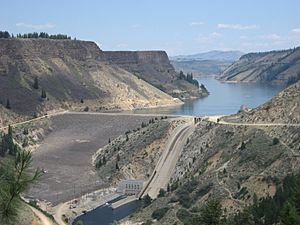List of dams and reservoirs in Idaho facts for kids

Idaho is a state with many rivers and a big need for water, especially for farming and making electricity. That's why you'll find lots of dams and reservoirs here! A dam is a huge wall built across a river. It holds back water, creating a large artificial lake called a reservoir. These amazing structures help us manage water for many important uses.
Contents
What Are Dams and Reservoirs?
Imagine a giant wall built across a river. That's a dam! It stops the water from flowing freely and collects it into a big lake behind it. This lake is called a reservoir. Think of it like a giant bathtub for a river.
Why Do We Build Dams?
Dams are super useful for several reasons:
- Storing Water: They save water from rainy seasons or melting snow. This stored water can then be used during dry times for farms or cities.
- Making Electricity: Many dams have power plants. Water flows through huge turbines, spinning them to create clean electricity. This is called hydropower.
- Controlling Floods: Dams can hold back extra water during heavy rains, preventing floods downstream that could damage homes and farms.
- Recreation: Reservoirs are also great places for fun activities like boating, fishing, and swimming!
Idaho's Important Dams
Idaho has many dams, each built for a specific purpose. Some are very tall, and some create huge lakes. Here are a few examples:
Tallest Dams
- Dworshak Dam: This is one of the tallest dams in the United States! It's on the North Fork Clearwater River and stands a whopping 717 feet (218 meters) high. That's taller than many skyscrapers! It helps control floods and makes a lot of electricity.
- Anderson Ranch Dam: Located on the South Fork Boise River, this dam is 456 feet (139 meters) tall. It's the second highest dam in Idaho and creates a large reservoir used for irrigation and power.
- Brownlee Dam: On the Snake River, this dam is 420 feet (128 meters) tall. It's part of a series of three dams that make a lot of electricity for Idaho.
Dams for Power
Many dams in Idaho are built to generate hydropower. This means they use the force of water to spin machines that create electricity.
- Brownlee Dam and Hells Canyon Dam on the Snake River are great examples. They produce a lot of power for homes and businesses.
- Cabinet Gorge Dam on the Clark Fork River also makes a significant amount of electricity.
Dams for Farming
Idaho is famous for its agriculture, and dams play a huge role in watering crops.
- American Falls Dam on the Snake River creates a massive reservoir that stores water for irrigation across a wide area.
- Minidoka Dam and Milner Dam, also on the Snake River, are vital for delivering water to farms in southern Idaho.
- Palisades Dam on the Snake River stores a huge amount of water, which is released slowly to help farmers downstream.
Types of Dams You Might See
Dams aren't all built the same way! Here are some common types:
- Earthfill Dams: These are made mostly of packed dirt, sand, and rock. They are wide at the bottom and get narrower towards the top, like a big hill. Many dams in Idaho, like Anderson Ranch Dam and Palisades Dam, are earthfill dams.
- Concrete Gravity Dams: These are solid walls of concrete. Their weight holds them in place against the force of the water. Dworshak Dam is a good example.
- Concrete Arch Dams: These dams are curved, like an archer's bow. The curve helps push the water's force into the sides of the canyon, making them very strong. Arrowrock Dam and Salmon Falls Dam are arch dams.
- Rockfill Dams: Similar to earthfill, but made mostly of large rocks. Oxbow Dam is a rockfill dam.
See also
- List of lakes of Idaho
- List of dams in the Columbia River watershed
- List of dam removals in Idaho

